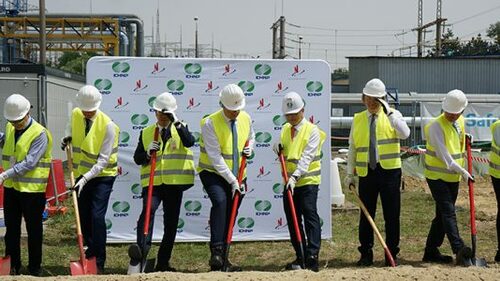Ceremony for the Inauguration of the Works at the Tritium Removal Facility in Cernavoda Nuclear Power Plant in Romania
Bucharest – The National Company Nuclearelectrica SA and Korea Hydro & Nuclear Power (KHNP) announce the start of works on the first tritium removal facility in Europe, located at the Cernavoda Nuclear Power Plant. This initiative marks a significant step forward in nuclear technology and environmental protection, in line with the European Union’s sustainability objectives.
The tritium removal facility will remove tritium from the plant, leading to increased environmental protection, fully in line with Nuclearelectrica’s and Europe’s ESG objectives. Using an innovative Romanian technology, developed by the National Research and Development Institute for Cryogenic and Isotope Technologies – ICSI Rm. Vâlcea, the Cernavoda Detritiation Facility (CTRF) will be the third largest in the world and the first in Europe and will offer Romania the opportunity to become a European centre for the production and export of tritium – the candidate fuel for future fusion reactors. Romania also has the opportunity to develop its supply chain and become a centre for the development and export of Romanian technology and know-how, using local plants and workforce.
The CTRF project, carried out by ICSI Rm. Vâlcea, uses the most advanced technology, CTRF including updated nuclear safety requirements for an industrial tritium removal facility, as set by the Romanian National Commission for the Control of Nuclear Activities (CNCAN).
“We are pleased to implement an innovative Romanian technology together with KHNP, a leading nuclear expert, to achieve a safe and reliable project. The tritium removal facility demonstrates Nuclearelectrica’s commitment to safe operations and environmental protection. This project underlines Romania’s leading role in the nuclear industry and contributes to national energy security,” said Cosmin Ghiță, CEO of Nuclearelectrica.
“The groundbreaking ceremony of the CTRF is a very important milestone which signifies the execution of the project in earnest. KHNP, in collaboration with Nuclearelectrica, will successfully complete the CTRF. The facility will enhance environmental protection, while contributing to safe operation of the Cernavoda NPP and economic growth of the country as well. Going forward, I expect the nuclear industries between Romania and South Korea will have closer and stronger collaboration”, said Jooho Whang, CEO of Korea Hydro & Nuclear Power (KHNP).
The inauguration ceremony took place at the Cernavoda NPP site, with the participation of Nuclearelectrica and KHNP teams, together with collaborators from the National Research and Development Institute for Cryogenic and Isotope Technologies – ICSI Rm. Vâlcea.
About KHNP
KHNP (Korea Hydro & Nuclear Power Co., Ltd.), the largest electric company in the Republic of Korea, generates 29.6% of the nation’s domestic electricity. With a portfolio comprising 25 nuclear power plants, 21 hydro power plants, 16 small hydro power plants, 16 pumped storage power plants, 55 solar power plants, and 1 wind power plant, KHNP is committed to providing carbon-free energy solutions. Ongoing projects include the construction of three new nuclear power plant units in Korea and various international projects, such as the Barakah nuclear power project in the UAE and the El Dabaa nuclear power plant in Egypt. KHNP, a nuclear and renewal energy company, prioritizes safety, reliability, and environmental sustainability, ensuring a brighter future through innovation and collaboration in the energy sector.
Categories
Latest news
Clariant's MegaMax™ 900 catalyst: Powerful start at European Energy's e-methanol plant
European Energy successfully started up their e-methanol plant in Kasso, Denmark, using Clariant’s MegaMax 900 catalyst. The Power-to-X plant is one of the world’s first and currently largest comme...
Kazakhstan’s largest petrochemical project: first piles driven for polyethylene plant in Atyrau
The construction of the plant, which has a capacity of 1.25 million tons of polyethylene per year and an investment of approximately 7 billion US dollars, is expected to be completed by 2028, with ...
Vynova Alkoxides GmbH awards first basic engineering contract for new alcoholates plant at the Lülsdorf site in Germany.
Vynova starts the construction of a new alcoholates plant at the Chemiepark Lülsdorf. A contract for basic engineering has been awarded to an external engineering company for finalising the basic d...
Norway: TotalEnergies and partners launch the 2nd phase of Northern Lights CCS project
Northern Lights will increase its CO2 storage capacity to more than 5 Mt per year. Northern Lights signed a commercial agreement with Stockholm Exergi for transport and storage of 900 kt CO2/y, fro...
